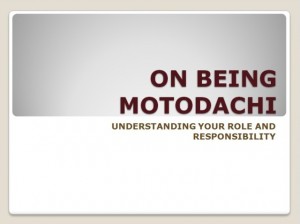Building the kendo community takes motivated students, and an approach to teaching that fosters individual progress with community growth.
Enhancing Motivation
The individual student has to have the motivation within them. The assumption rightly, or wrongly, being they have some level of motivation or they would not be in your class. Kendo is a voluntary activity for teens and adults.
Young kids that start kendo because of a desire on the part of parent(s) are much less likely to be motivated to do kendo. In general, the majority of these students drop out because they did not want to do kendo to begin with.
I made a rule long ago, I do not take kids whose parents want the kendo, I only take kids that want to do kendo.
Quizzing the parents, when possible, is always a good chance to avoid a serious waste of time, effort, and resources on the reluctant child.
Motivation is a force within the individual to succeed, and is the grit and guts to push themselves beyond. Tapping into and enhancing motivation requires that the club/class/sensei provide the environment and tools for the individual’s motivation to increase.
Individual Mentoring
Mentoring and motivation enhancement are closely related but not the same. Mentoring is primarily a hands on approach at guiding the individual and removing roadblocks that they cannot remove themselves. Before removing any roadblock, it is critical for the individual to struggle to remove it themselves. Part of mentoring is to be a spirit guide – not in the traditional sense, but as someone that has already been down the path, help guide the individual to make the right turns and understand the process. Mentoring also means helping with technical corrections and making training suggestions.
Fostering Relationships
To build a community it takes everyone – students to teachers, and children to adults. Therefore the approach to each group needs to be intentional to the group involved.
For Children and Kids:
Make it fun.
Children need to bond together so that they have friends in kendo, and so that the atmosphere at the dojo is not oppressive but uplifting and challenging. Group suffering is good and provides pride of accomplishment.
Guidelines for children practicing Kendo
Incorporate special youth camps that include games beyond kendo, or kendo based games like:
- Tsuba Toss – contest to see who can toss their tsuba into their men (in the fashion of a water balloon toss)
- Race to put on bogu
- Suri ashi Race – like a relay race in track
- Sensei Says – done like Simon Says, increasing # of repetitive strikes (e.g. men; kote-men, kote-men-hiki doh, etc…)
- Balloon War – taping balloons to targets, strike to pop the balloons, last one standing wins
- Piñata – blindfolded with bokken
Have outside activities like a swim party or bowling party – any kind of activities that make the child want to come to kendo to be with their friends.
For Teens and Adults:
Drilling needs to carefully build correct habit, so there is continual process improvement through repetition – each time getting better. This produces excellence even if you are not a “natural.” Experience and training gets you to the top level of excellence beyond the norm.
Talent needs to be combined with effort to produce highly skillful kenshi. This skill with effort brings achievement in shinsa and shiai. This makes you a valuable commodity in the overall group because you can now contribute to the community as a whole. The community is the whole, and unless we grow the community we will not grow on a personal level.
Think in one direction, combine together by means available from the things around you, and pay attention to detail.
We have the following kendo opportunities available:
- Women’s Practice on Friday @ Bellevue
- Special Saturday Classes
- Youth Camp
- Yudansha Workshop
- Seminars
Showing up – attendance is the beginning
